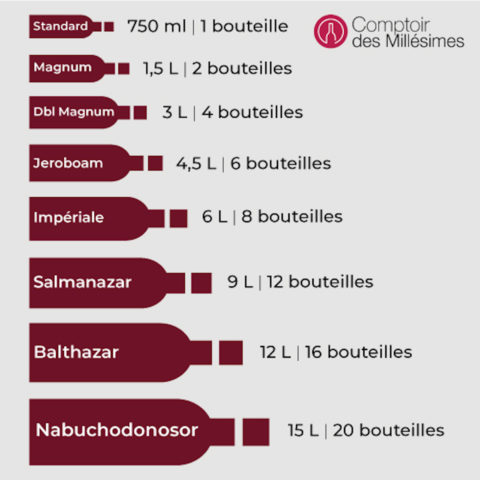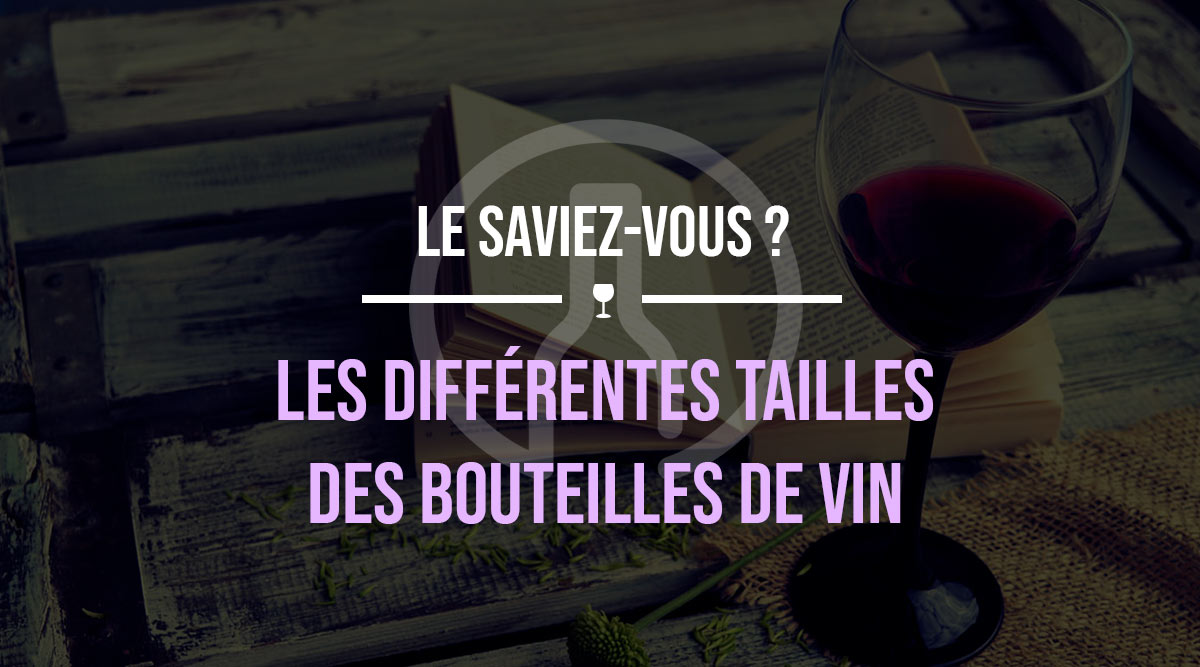Here we present the various wine bottle formats as well as their oenological interest. From the smallest size with the quart (20cl) to the Melchisédech (30 liters), not forgetting the famous Jeroboam (6 liters), discover all the sizes, formats and capacities of the bottles our winemakers produce.

Small bottles
- Quarter 20 cl
- The half-bottle, also known as the fillette, 37.5 cl
The most common bottle sizes
- Standart 75 cl bottle
- Magnum 1.5 L (equivalent to 2 bottles)
- Double Magnum 3 L (equivalent to 4 bottles)
- Jeroboam 4.5 L (equivalent to 6 bottles)
Large formats
- Impériale 6 L (equivalent to 8 bottles)
- Rehoboam 4.5 L (equivalent to 6 bottles)
- Salmanazar 9 L (equivalent to 12 bottles)
- Balthazar 12 L (equivalent to 16 bottles)
- Nebuchadnezzar 15 L (equivalent to 20 bottles)
Large Champagne formats
- Salomon 18 L (equivalent to 24 bottles)
- Souverain 25 L 'equivalent of 35 bottles)
- Primat 27 L (equivalent to 36 bottles)
- Melchisedech 30 L (equivalent to 40 bottles)
A little help for those who don't remember the names of the different bottle sizes:
"For early in the morning I failed to notice its natural banality", this sentence uses, in ascending order, the first letters of each format between quarter and Nebuchadnezzar: quarter / half / bottle / Magnum / Jeroboam / Rehoboam / Methuselah / Salmanazar / Nebuchadnezzar.
Why are there so many bottle sizes?
In addition to the Magnumthe Jeroboam or the standard bottle there are different bottle formats but many remain relatively unknown.
As well as the prestigious image associated with large formats, they are also of oenological interest. The larger the bottle, the longer it can be aged. This is due to the lesser interaction between oxygen and wine in the cellar. Large formats are less likely to undergo temperature changes, thanks to the thickness of the glass, which allows the wine to age evenly.
What's more, winemakers are said to reserve their best production for these large formats, as their most loyal customers are often the buyers.
Are large formats all they're cracked up to be? There's a small downside to large formats: as the bottles require very specific corks, they are cut individually. It can happen that the corks aren't cut perfectly, so the wine doesn't age as well. But this is the exception.
Winegrowing is an integral part of the French landscape and culture, so it's no great surprise that the various bottle formats in existence are named after the kings of the Bible, our oldest text.
What's the biggest bottle of wine in the world?
The record for the bottle with the largest volume went to an exuberantly large bottle measuring 2.40 m and 68 cm in diameter, containing 460 liters of wine exhibited in the Austrian restaurant Gasthaus Zum Gupf.
>> Find out more about our Magnums de Grands Vins





![✨ Comptoir des Millésimes honors Champagne's great winemakers ✨[LINK TO THE ORGANIC CELLAR]We've selected 11 exceptional estates that reveal the full richness of Champagne terroir through unique, refined cuvées. Hugues Godmé - In Verzenay, this family-run biodynamic estate offers precise, vibrant champagnes with a beautiful mineral tension.Egly-Ouriet - A benchmark for the Montagne de Reims, its powerful champagnes, aged for long periods in barrel, impress with their complexity.Moussé Fils - In Cuisles, the Meunier grape is king. Pertois-Moriset - Pure, taut Chardonnay Grands Crus for lovers of chalky finesse. A fine address in Mesnil-sur-Oger.Geoffroy - In Aÿ, this domaine produces fine champagnes, carefully crafted and barrel-aged to reveal the full complexity of the terroir.Larmandier-Bernier - Biodynamic viticulture, exceptional parcels and purity. Crystal-clear, intense champagnes for connoisseurs.Roger Coulon - Eight generations of expertise at Vrigny. Balanced, subtle and elegant champagnes.A. Bergère - In Avize, a dynamic house offering expressive, fruity and accessible cuvées.Adrien Renoir - A promising talent from Verzy, he produces fine, complex champagnes with a true sense of terroir.De Sousa - Emblematic house in Avize. Richness, depth, long ageing: Chardonnay at its peak.Pierre Paillard - In Bouzy, the family magnifies Pinot Noir with vinous, racy and sincere cuvées.📦 Order now on our website#ComptoirdesMillésimes #Champagne #VigneronsIndépendants #GrandVin #ChampagnesdeTerroir #LivraisonRapide](https://www.comptoirdesmillesimes.com/blog/wp-content/plugins/instagram-feed/img/placeholder.png)
patch:
exhibited in the Austrian restaurant Gasthaus Zum Gupf.
this restaurant is located in Switzerland, in the canton of Appenzell
sincerely